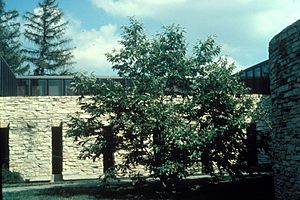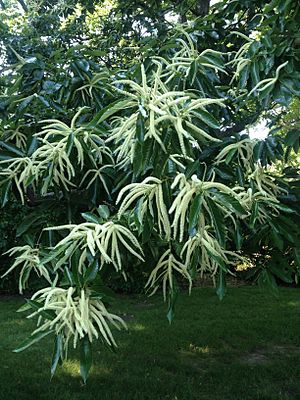Chinese chestnut facts for kids
Quick facts for kids Chinese chestnut |
|
|---|---|
 |
|
| Conservation status | |
| Scientific classification |
The Chinese chestnut (scientific name: Castanea mollissima) is a type of chestnut tree. It is part of the Fagaceae family, which also includes oak trees. This tree is native to China, Taiwan, and Korea. It is well-known for its delicious nuts.
Contents
What Does It Look Like?
The Chinese chestnut is a deciduous tree. This means it loses its leaves in the fall. It can grow up to 20 meters (about 65 feet) tall. It has a wide, spreading top, called a crown.
Its leaves grow alternately along the branches. They are simple in shape and measure about 10–22 centimeters (4–8.5 inches) long. They are also 4.5–8 centimeters (1.8–3 inches) wide. The edges of the leaves have small teeth.
The flowers grow in long clusters called catkins. These catkins can be 4–20 centimeters (1.5–8 inches) long. The female flowers are at the bottom of the catkin. The male flowers are found on the rest of it.
The fruit of the Chinese chestnut is a round, spiky case. This case is called a cupule. It is about 4–8 centimeters (1.5–3 inches) across. Inside, you will find two or three shiny brown nuts. These nuts are usually 2–3 centimeters (about 1 inch) wide on wild trees. The scientific name mollissima means "very soft." This refers to the soft, fuzzy feel of its young shoots and leaves.
Where Does It Grow?
Chinese chestnuts have been grown in East Asia for thousands of years. Because of this, it is hard to know exactly where they first came from. Today, they grow in many parts of China. This includes provinces like Anhui, Fujian, and Guangdong. They also grow in Taiwan and Korea.
In the northern areas, these trees grow close to sea level. In the southern parts, they can be found at high altitudes. They grow up to 2,800 meters (about 9,200 feet) high. Chinese chestnuts like a lot of sunshine. They prefer soil that is acidic and loamy. They grow at a medium speed.
How It Deals with Disease
Chinese chestnuts have lived alongside a serious tree disease for a very long time. This disease is called chestnut blight. It is caused by a fungus named Cryphonectria parasitica. Over time, Chinese chestnuts have developed a strong natural resistance to this blight. They are probably more resistant than any other chestnut species. Even if they get infected, they usually only have minor damage.
However, not all Chinese chestnut trees are equally resistant. Some trees are quite strong against the disease. Others might be more easily affected. The Japanese chestnut also has some resistance. The European chestnut is less resistant.
In the 1890s, Chinese and Japanese chestnuts were brought to the United States. People wanted to grow them for their nuts. Unfortunately, these imported trees also brought the chestnut blight with them. The native American chestnut trees had no resistance to this disease. The blight was first seen in New York in 1904. It quickly spread and destroyed almost all American chestnut trees. Within 30 years, nearly all of them were gone from their natural homes.
Today, scientists are working to cross-breed Chinese and American chestnuts. They want to combine the best features of both trees. They hope to create new trees that are tall and have sweet nuts like the American chestnut. At the same time, these new trees would have the strong blight resistance of the Chinese chestnut.
What Are Its Uses?
The nuts of the Chinese chestnut are edible. They are widely grown in eastern Asia. More than 300 different types, called cultivars, have been chosen for their nut production. These types are grouped into five main regions in China. Some cultivars, like 'Kuling' and 'Nanking', produce large nuts. These nuts can be up to 4 centimeters (1.5 inches) wide.
The nuts are sweet. Some people think they taste the best of all chestnuts. Others believe they are not as good as the American chestnut. Besides being eaten by people, the nuts are also an important food source for wildlife.
See also
 In Spanish: Castaño chino para niños
In Spanish: Castaño chino para niños



